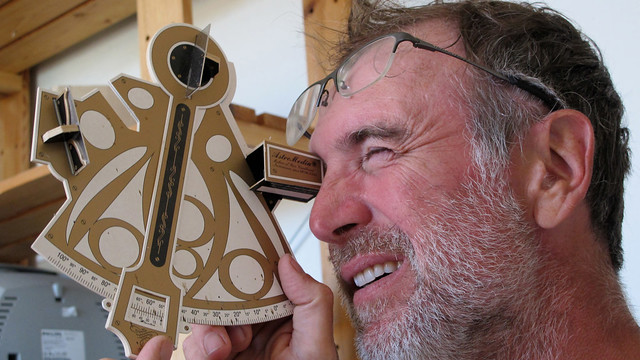
In Passau, is time for new guests to joins us. Marco comes with his girlfriend Naike, in a chilly morning over a steamy river. Marco is a big man, Naike a tiny girl: They make for a nice couple.
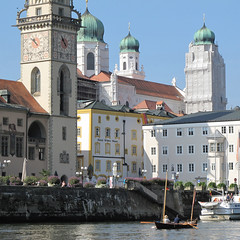 Passau is beautiful: Three rivers, three waters, rocks, tourism and life. The Inn is the biggest of the rivers and the most powerful, thanks to the glaciers feeding it.
Passau is beautiful: Three rivers, three waters, rocks, tourism and life. The Inn is the biggest of the rivers and the most powerful, thanks to the glaciers feeding it.
Hang on… Why, then, is the main river called Danube? It should be called Inn, since the Danube flows into the Inn and not the other way around! Just think how many litres of ink could be saved by using the shortest name…
Misteries of us (in) sapiens.
Since I’m not a tourist guide, I won’t tell you about Passau’s sights, but rather about what you can’t easily spot there: The the disaster carried out on the Danube, whose banks have been covered with cement, killing life. It’s so sad.
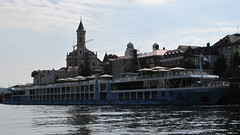 Not to mention the big cruise ships living from here, directed to south-east: They will be an environmental curse for many years to come, until someone understands that the only way to save the river is to stop them.
Not to mention the big cruise ships living from here, directed to south-east: They will be an environmental curse for many years to come, until someone understands that the only way to save the river is to stop them.
The poor elders, taken around by picturesque women in traditional garments who feed them with “local” specialties, seem to enjoy it. However I haven’t had the guts to interview any of them yet, since the sheer view of these ships makes me sick. If, one day, you’ll try to row along a river, you’ll understand why. In some way, it feels like walking down a heavily truck-trafficked road…
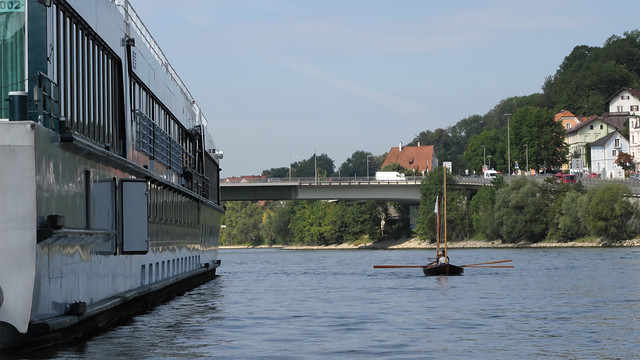
After Passau the Danube gets bigger, not in width (never larger than 400 m) but as scenery.
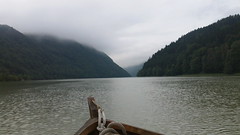 The gorges are now higher and the light, filtering through the clouds, colours the many forests.
The gorges are now higher and the light, filtering through the clouds, colours the many forests.
The water, thanks to the Inn, is now of a greyish-green colour but quickly changes according to the sky. At one moment it looks like Patagonia, another one like a Norwegian fjord.
I can spot many signs of Vikings, whether true or fake: I stumble into a Viking boat and an authentically false Viking village. I believe they’re just educational reproductions.
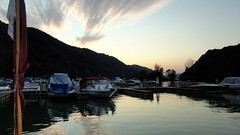 In the evening, after 45 very hard kilometers rowed with a great Marco on my side, we get to Schlogen, arguably the most famous meander on the Danube. The temperature is cold, remembering me that Autumn’s coming. The marina’s director, who’s humbly lawn-mowing, grants us free stay. In exchange, we buy two Austrian courtesy flags.
In the evening, after 45 very hard kilometers rowed with a great Marco on my side, we get to Schlogen, arguably the most famous meander on the Danube. The temperature is cold, remembering me that Autumn’s coming. The marina’s director, who’s humbly lawn-mowing, grants us free stay. In exchange, we buy two Austrian courtesy flags.
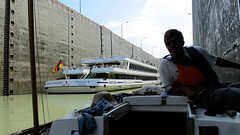 We’re now in Austria, having successfully passed our first 2.000 km of travelling. Not many changes from Germany: Faster locks with mandatory life-vests but with no hassles for rowboats. There’re many biegarten and, being such good beergardeners, we often stop to check if everything’s growing fine.
We’re now in Austria, having successfully passed our first 2.000 km of travelling. Not many changes from Germany: Faster locks with mandatory life-vests but with no hassles for rowboats. There’re many biegarten and, being such good beergardeners, we often stop to check if everything’s growing fine.
Marco shows a natural talent for beergardening. He’s founded the Sailing Club OltrePo and is very committed in spreading the love for rivers and waters. He also loves beer and we’ll have a very good time in a Gasthof, waiting for the heavy rain to stop. On the outside, low clouds find their way through the pine trees: We’re in the Alps.
The following day we set off early, crossing wonderful sceneries. Despite the usual rip-raps, the Danube is still very nice because of the unique contrast between sweetness and austerity that curiously live together.
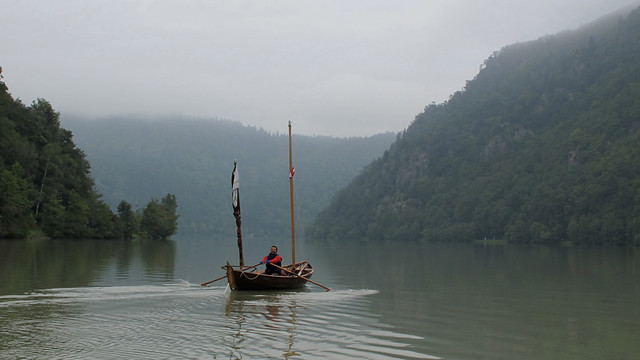
This third day with Marco and Naike begins with a rowing in Olympic fashion. After a while, I have to land to find an Internet connection, so I say to Marco: “Keep going for a while, then wait for me. If you like it, go ahead, slowly though.” Probably he misses the last two words and keeps going relentlessly!
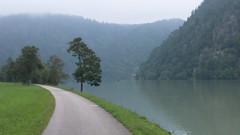 So I start walking along the valley, following the wonderful cycling route Radweg R1 that spans from the sources of the Danube down to the mouth.
So I start walking along the valley, following the wonderful cycling route Radweg R1 that spans from the sources of the Danube down to the mouth.
Marco gets some help from the current, so I can’t reach him. In a little harbour, I meet Bruno who offers me a lift aboard Serena.
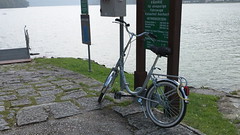 I prefer not, so I ask him to give me the magical Graziella (Paolo’s bike) and start riding toward Linz, 32 km away.
I prefer not, so I ask him to give me the magical Graziella (Paolo’s bike) and start riding toward Linz, 32 km away.
The bike flies: The trail is beautifully marked, plenty of biergarten (but I can’t stop by…), a hilly landscape with some mountain.
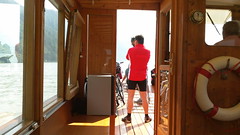 I cross the Danube aboard a ferry (a sort of floating chalet) to cut a route that otherwise would take me up to a steep mountain. I find many riders: A British man helps me to pump up my bike’s wheels.
I cross the Danube aboard a ferry (a sort of floating chalet) to cut a route that otherwise would take me up to a steep mountain. I find many riders: A British man helps me to pump up my bike’s wheels.
Then, I see the aforementioned Viking boat and camp.
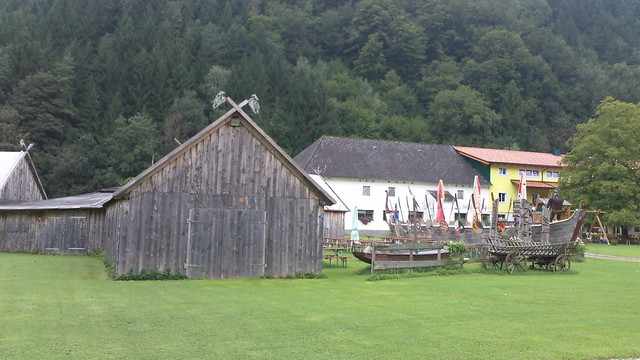
In the collective imagery, Vikings are everywhere: Certainly they’ve been in these places, I can feel it.
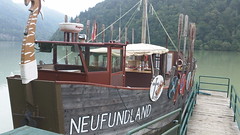 Here it looks like Norway, even if I imagine them looking for something warmer and more cheerful. Instead, I would happily stay here, liking nature and cold temperatures.
Here it looks like Norway, even if I imagine them looking for something warmer and more cheerful. Instead, I would happily stay here, liking nature and cold temperatures.
What a pleasure in using my legs once again! The mountains are now behind me and the Danube opens up in a wide valley. Thirty-two kilometers in three hours on my bike, not bad. Linz welcomes me with a nice descent, the cars being very close since the Radweg runs now side-by-side to a main road.
How nice these cycling routes, far from noisy cars! I would be so glad if cars were abolished, waiting for a cleaner and more intelligent engine than the internal combustion one (nearly two centuries old). Hurray to bicycles! Light and silent.
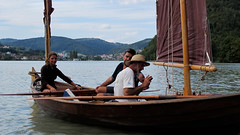 Do you consider logical that a 1 ton (or more) car is being used to usually move a tiny 70 kg man? Maybe for only a few minutes trip. Clodia weights 120 kg and moves (loaded with Marco, Naike and me, plus various equipment) about 300 kg. We quietly cover 50 km per day, windless. Is it reasonable?
Do you consider logical that a 1 ton (or more) car is being used to usually move a tiny 70 kg man? Maybe for only a few minutes trip. Clodia weights 120 kg and moves (loaded with Marco, Naike and me, plus various equipment) about 300 kg. We quietly cover 50 km per day, windless. Is it reasonable?
In Linz I see a two-storey bus, London style, and I immediately smell a lovely scent of madness. My senses are hardly wrong. Solar ovens, strange recycling, a three-wheeled equipped with pizza oven, bicycles, and much more on the Danube bank.
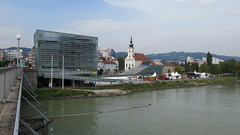 This is an exhibition called “Create your world 2011”, organized within a very interesting centre called Ars Electronica.
This is an exhibition called “Create your world 2011”, organized within a very interesting centre called Ars Electronica.
It gets together and awards ideas from all around Europe about a wiser world, based on the three R’s: Recycling, Reuse and Reduce. At first sight, the results seem encouraging.
I drink an apparently expensive apple juice: 5 euros, but the price includes a caution of 2 euros to bring the glass back. A very effective idea, since the area is quite clean.
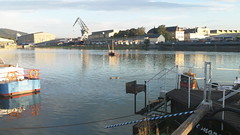 I’ve arrived in town before Clodia, so I look around to find a mooring spot. I know that, down the valley at km 2.132, there’s the Winterhafen, the winter port. I get there in a few minutes by following the route along the Danube, still channeled. Before the pier there are some nice gravel beaches where people take a bath and rest. In the port there are three rowing clubs, one of them called Viking, for a change…
I’ve arrived in town before Clodia, so I look around to find a mooring spot. I know that, down the valley at km 2.132, there’s the Winterhafen, the winter port. I get there in a few minutes by following the route along the Danube, still channeled. Before the pier there are some nice gravel beaches where people take a bath and rest. In the port there are three rowing clubs, one of them called Viking, for a change…
A bizarre boat, “Eleonore”, catches my attention: It’s surrounded by wooden platforms, a windmill, solar panels, a rainwater harvesting system. A board labels it as a part of a project about artists’ houses. Once again I can smell madness: When I come back, later on, I find a nice space-girl wrapped in a silver spacesuit, who’s talking at the phone.
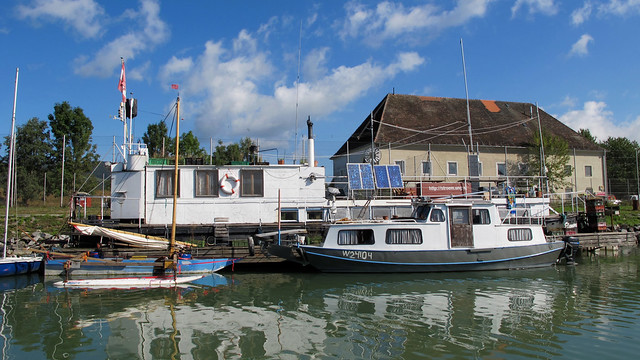
Smiling, she tells me that the boat belongs to an artist, Franz. I ask permission to moor Clodia, that’s coming with Fine and Naike aboard, next to them. Liesbeth, that’s the girl’s name, calls Franz who says that’s fine. Fantastic!! As always, mad help each other.
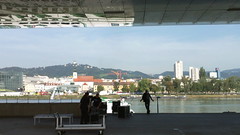 Linz suddenly shows its industrial beauty: The harbours and the steel mills have marked its recent history, while transports and salt that of the past.
Linz suddenly shows its industrial beauty: The harbours and the steel mills have marked its recent history, while transports and salt that of the past.
The Danube has decided the fate of this city, as it has done to all the cities that we’re going to see from now on.
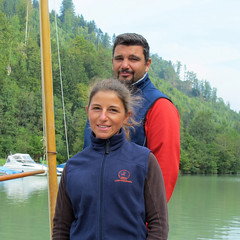 Marco and Naike leave us the next morning. They have to get back to Italy to run their restaurant in Stradella. Go to see them, close to the exit of A21 motorway: They’ll tell you about the good time we had on the Danube and many stories about the Po. Thanks friends.
Marco and Naike leave us the next morning. They have to get back to Italy to run their restaurant in Stradella. Go to see them, close to the exit of A21 motorway: They’ll tell you about the good time we had on the Danube and many stories about the Po. Thanks friends.
Our first day in Linz is quite warm. I take advantage of the temperature, oiling Clodia’s planking. In the morning I welcome aboard Bernd, an Austrian friend who’s still a bit battered from a night with too much schnapps and wine.
We sail between the big buildings around the Winterhafen: Zero wind, but Clodia keeps going anyway. In the meantime, Paolo is back from Bologna. In the afternoon, next to a strange Junk Rig catamaran built with a bit of everything and a bit of nothing by recycling different materials, I meet Tim.
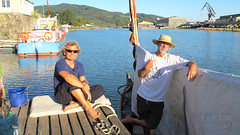 He’s Australian: Nice face and funny like only an Aussie can be. He lives in Linz by 20 years where he has founded “Time’s up”, a lab carrying on experiments about reusing and recycling. We row for a while talking about many things.
He’s Australian: Nice face and funny like only an Aussie can be. He lives in Linz by 20 years where he has founded “Time’s up”, a lab carrying on experiments about reusing and recycling. We row for a while talking about many things.
The time gets by fast and when we’re back many people are waiting for us aboard Eleonore: A Japanese artist living in New York, Franz Xaver (who I have now the pleasure to meet, a great man who creates situations as a Demiurge), and other creative individuals rich in wisdom and cheerfulness, of any age.
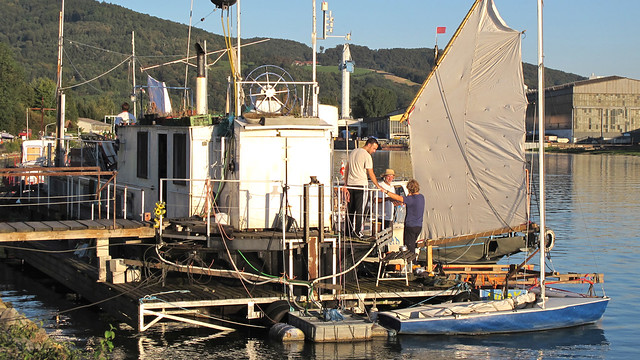
I forgot to tell that, while sailing, I’ve got boarded by a crazy dentist on a Canadian canoe. A playboy grin and many words in different languages: His name’s Ferdinand, a very cheerful guy. He’ll come back in our story later on.
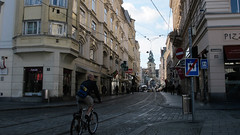 The following day is rainy and I take a ride to the city centre. A nice lady notices that I’m trying to caress her dog, complaining about how difficult it is to take dogs inside public premises in Italy. Here, they’re admitted everywhere. Then, we go back to “Create Your World” to interview the exhibitors.
The following day is rainy and I take a ride to the city centre. A nice lady notices that I’m trying to caress her dog, complaining about how difficult it is to take dogs inside public premises in Italy. Here, they’re admitted everywhere. Then, we go back to “Create Your World” to interview the exhibitors.
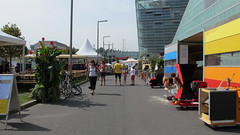 Sara Hossein, of Iranian origin, describes a game involving kids and teenagers in decisional processes about new sustainable ideas, while Thomas Schneider Katrin and Christoph Wiesmayr created an incredible structure for urban farming, by using hydro-culture and sun rays to nurture the plants.
Sara Hossein, of Iranian origin, describes a game involving kids and teenagers in decisional processes about new sustainable ideas, while Thomas Schneider Katrin and Christoph Wiesmayr created an incredible structure for urban farming, by using hydro-culture and sun rays to nurture the plants.
A system that would make self-sufficient many buildings, already used in many cities that have experienced a deep transformation crisis. An interesting meeting, that would deserve much more time, is that with professor Bergmann, who works in Detroit on innovative electric mobility systems.
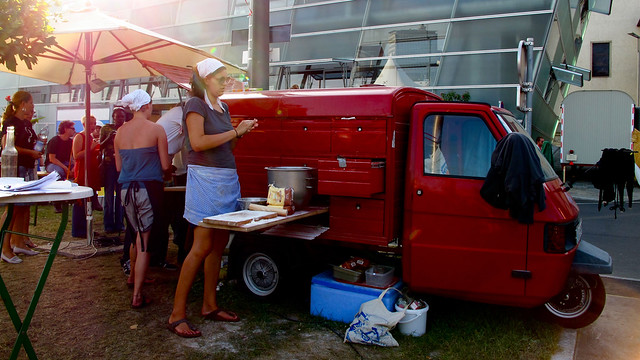
Also noteworthy the Polymobil by Andrea Strauss, a three-wheeler equipped with a real wooden oven to cook pizzas. Thanks to Victoria who has made them for us. And again, a project called “Import und Export” by Ernest Schmiederer and Marco Robert Büchl, working on migration, with very interesting videos and photos.
The websites will explain you much better every single project, ideated by researchers who’re nearly all under 19 years of age. Many people working on a better, possible world, not just an ideal one. Thinking about my homeland, I have to say: Poor Italy. However we have excellent ideas and projects too, but so far I have to stick to the usual cliché of the xenophile Italian.
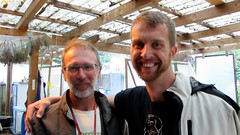 The next morning it rains and Christoph, the only man met so far that I can look from bottom to top (a great privilege and comfort for me), takes us by storm.
The next morning it rains and Christoph, the only man met so far that I can look from bottom to top (a great privilege and comfort for me), takes us by storm.
Architecht, good eyes, he takes me riding in an industrial and smoking Linz, bearing signs of so much work in war times.
Hitler decided to set up here one of the steel hubs for the construction of the Reich. Now, the work has decreased but it’s still intense.
A foolish project hurts Christoph (who comes from a fishermen’s family, a most valuable asset): The port is partially being filled in. But, as we know, nowadays land is considered so valuable and the Danube, from the point of view of big heavy ships, is underused. I think this project is a bit stupid too, watching to all these abandoned warehouses around. I smell speculation.
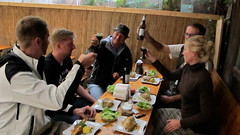 We have a fantastic lunch with fish and veggies coming from the last farm left on the Danube floodplain. Here Franz, Christoph’s brother, works as a farmer and fisherman: He wishes to run a restaurant serving only zero kilometers products. Needless to say that “hic manebimus optime” (we’ll have a very good time).
We have a fantastic lunch with fish and veggies coming from the last farm left on the Danube floodplain. Here Franz, Christoph’s brother, works as a farmer and fisherman: He wishes to run a restaurant serving only zero kilometers products. Needless to say that “hic manebimus optime” (we’ll have a very good time).
A new deluge comes down while we take a look to an artificial bay created by Christoph’s dad.
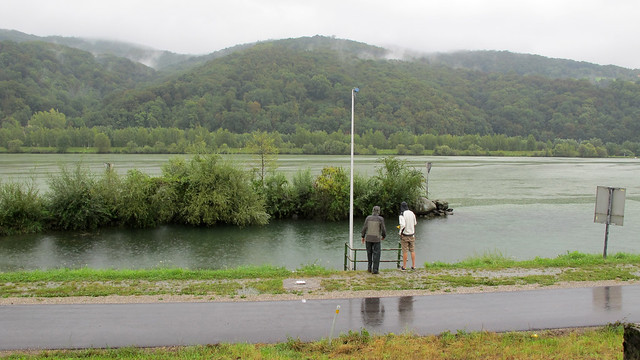
By using the warm cooling waters from a close factory, it gives fishes the chance to reproduce.
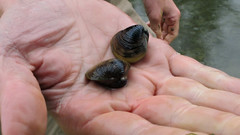 There are also freshwaters mussels called Filipino’s clams, the same currently invading the Venetian’s Lagoon, arrived here stuck to the tanks of the big ships coming from the Black Sea. They also deserved a free ride, we’re not the only colonizing species! In the evening I fall asleep cuddled by the sound of old engines, especially a two-strokes Junkers from 1940 coming from Holger’s boat that’s moored next to Eleonore. How nice! Even if I don’t like engines.
There are also freshwaters mussels called Filipino’s clams, the same currently invading the Venetian’s Lagoon, arrived here stuck to the tanks of the big ships coming from the Black Sea. They also deserved a free ride, we’re not the only colonizing species! In the evening I fall asleep cuddled by the sound of old engines, especially a two-strokes Junkers from 1940 coming from Holger’s boat that’s moored next to Eleonore. How nice! Even if I don’t like engines.
In the morning, reluctantly, we leave. I welcome aboard the mad dentist and I have an exhilarating time listening to his Serbian songs.
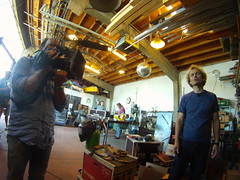 We pay a last visit to Tim’s lab, in the little harbour next to the Winterhafen. A world of ideas and product of the mind.
We pay a last visit to Tim’s lab, in the little harbour next to the Winterhafen. A world of ideas and product of the mind.
Thanks Tim, you’ve been great! “Ti xe veramente un pirata” (“You really are a pirate” that’s a compliment in Venice!!). The real piracy had rules and honour codes, as opposite to the coward robbery disguised as piracy.
We’re now in Grein, little pearl of the OberOsterreich where the Danube has allowed to create a happy and rich wisdom island. It rains, I’ve met many people and angels. One of them, Horst, is hosting me.
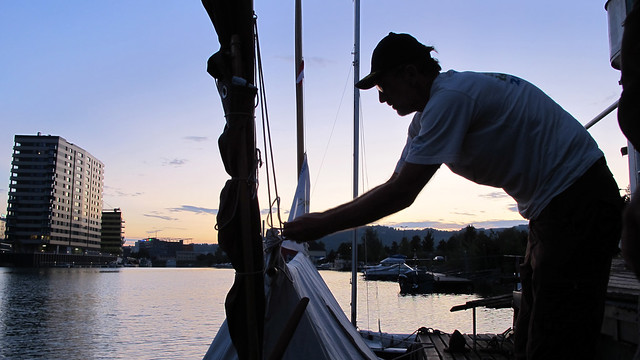
I’m very tired. The kilometers and the intensity of the journey, the encounters, the work, the continuous communication, the information to learn, elaborate and give back, make me feel their weight. And it’s colder, Autumn is at our doors.
But for this, you’ll have to wait my next story, from Wien.
Auf Wiedersehen!
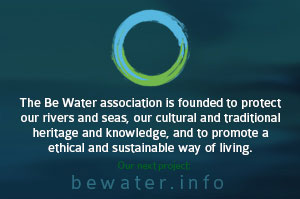























Hello my friend,
as I can see today, U reached Vienna – a really wonderful place !
Hope U Grande Giaco, Fine and Bruno are all well and U can enjoy the beautiful capital of Austria.
I press all my fingers for a really good forthcoming of your journey to the black sea. I remember a lot the nice time we had together at the main river. God bless U
lots of hugs
Holger
Ciao Giacomo, vedo che l’avventura procede a gonfie vele! Non sai quanto avrei voluto raggiungerti anche io. In bocca al lupo per le prossime tappe. Un abbraccio barbara
Non sai quanto avrei voluto raggiungerti anche io. In bocca al lupo per le prossime tappe. Un abbraccio barbara
Grande Holger,
Thank you!! I hope that as soon as possible you will reach us again. Many wonderful persons, ideas, landscapes..waterscapes.
A presto
i tuoi racconti sono davvero meravigliosi, semplici e pieni di cose
… mi sembra quasi di essere lì con te
che bel viaggio giacomo! bravo!
ti abbraccio
camilla